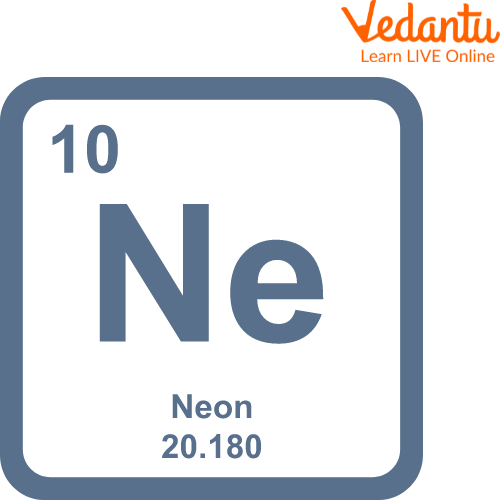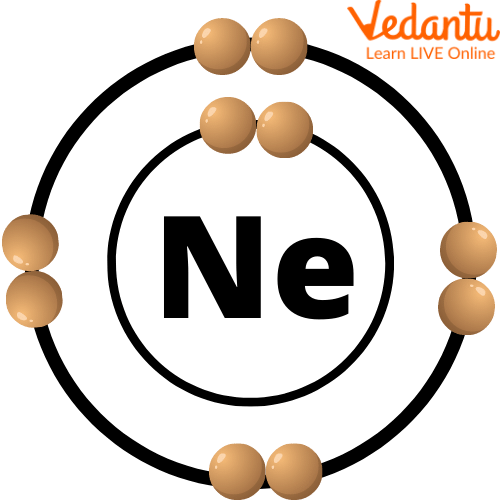




Why is Neon Important in Daily Life and Science?
Do you know why there is reddish-orange colour in the lamps? It is because of Neon, a gas present in them. Neon is a chemical element that exists in the form of gas in nature. It is chemically inert or not reactive, which means that it does not form compounds with other elements. This gas is denser than air and is found within the rocks in the Earth's crust.

Neon Symbol, Atomic Number and Mass
Neon element is used to manufacture everyday products, such as refrigerators, television, computers, etc.
This article will cover details on the neon atomic number, properties, uses and facts.
What is the Neon Atomic Number?
Neon is the second lightest noble gas in the periodic table after helium. It is because of the stable atomic structure of neon. Scientists have determined the atomic number of neon as 10. The neon symbol is Ne. It has an atomic mass of 20.180 units. It exists as a molecule, Ne2. The molecules are attached with a single bond.
What are the Physical and Chemical Properties of Neon?
The atomic structure of neon is stable, which makes it less reactive. Further, it is responsible for determining the physical and chemical properties of the element.

Structure of Neon
Physical Properties
The physical properties of neon are;
It is a reddish-orange or brown odourless gas.
Its boiling and melting points are -246.046 °C and -248.59 °C.
Its density is 0.000825 g/cm3.
It exists in a gaseous state at a temperature of 298 K.
Chemical Properties
As neon is chemically inert, It hardly shows any chemical properties. However, it exceptionally reacts with fluorine and forms unstable hydrates (neon combining with water molecules).
What are some uses of Neon gas?
Some uses of neon gas in everyday life are given below:

Neon Light
The most familiar use of neon is neon light. The bright red-orange coloured lights are used by the advertisement industries to make hoardings.
Neon bulbs are used in botanical gardens and greenhouses to enhance plant growth as these bulbs increase the amount of chlorophyll in plants.
Many industries use neon to manufacture security devices such as lightning arresters.
Neon is used in high voltage indicators to produce warning lights.
As neon is an unreactive gas, it is used as a refrigerant in many industries.
Plasma screens are made from neon so that they can display clear images and videos.
Oil industries use neon to find leaked paths in the containers.
The aircraft industry uses neon as a coolant. It is also used to manufacture aircraft equipment.
The automobile industry uses neon to make light lamps for vehicles.
Some Facts About Neon
Neon was first discovered in 1898 by two British scientists, Sir William Ramsay and Sir Morris Travers.
It is the fifth most abundant element on earth.
Neon is used in vacuum and plasma tubes, lasers, etc.
It is two-thirds times heavier than air.
Neon light can pass through the fog. Hence, aircraft use it while travelling in cold regions.
It is a rare gas and is more expensive than other elements.
It is 55 times more costly than liquid helium.
It can cause frostbite (injury to body parts due to extreme cold).
Summary
Neon is a noble or inert gas found on earth. It is heavier than helium. The atomic number of neon is 10, and the symbol is Ne. It produces reddish-orange and brown-coloured light when added to fluorescent lamps. It has a stable atomic structure which prevents it from showing robust reactivity and makes it one of the inert elements in the periodic table. This means that neon does not form compounds with other elements. Further, it plays an important role in manufacturing daily life electronic items, including lights, refrigerants, television sets, etc. Besides, aviation companies highly use neon to manufacture cooling sprays or coolants on a large scale to make aircraft work properly.
FAQs on Neon Element: Key Facts, Properties & Everyday Uses
1. What is Neon and what are its fundamental properties as per the NCERT syllabus?
Neon is a chemical element with the symbol Ne and atomic number 10. It is a noble gas, which means it is chemically inert or non-reactive under normal conditions. According to the NCERT curriculum, its key properties include being a colourless, odourless gas at room temperature with a stable atomic structure and an atomic mass of approximately 20.180 u.
2. Where is Neon located in the periodic table and why is its position significant?
Neon is located in Group 18 and Period 2 of the modern periodic table. Its position is significant because Group 18 contains all the noble gases. Neon's electron configuration (2, 8) features a completely filled outermost electron shell (valence shell), known as a stable octet. This stability is the primary reason for its chemical inertness and its placement among other noble gases like Helium and Argon.
3. What are the most common real-world examples and uses of Neon gas?
Neon is famously used in advertising signs and high-voltage indicators. Its main applications include:
- Neon Lighting: It produces a brilliant reddish-orange glow when an electric current passes through it, making it ideal for advertising signs.
- High-Voltage Indicators: Used in devices to show the presence of high voltage.
- Cryogenic Refrigerant: In its liquid form, neon is an effective refrigerant for cooling equipment to very low temperatures.
- Lasers: It is used in helium-neon (He-Ne) lasers.
- TV Tubes: Neon is used in the production of plasma display panels and television tubes.
4. Why is Neon considered a noble or inert gas?
Neon is considered a noble or inert gas because of its stable electron configuration. A neon atom has 10 electrons, with 2 in its first shell and 8 in its second (outermost) shell. Since its outermost shell is completely full, it has no tendency to gain, lose, or share electrons to form chemical bonds with other elements under standard conditions. This electronic stability makes it highly non-reactive.
5. How do neon signs produce their characteristic reddish-orange glow?
A neon sign works by applying a high voltage across a sealed glass tube filled with low-pressure neon gas. This electrical energy excites the neon atoms, causing their electrons to jump to higher energy levels. When these electrons fall back to their original, stable levels, they release the extra energy in the form of photons of light. For neon, the energy released corresponds to light in the reddish-orange part of the visible spectrum.
6. Are all colourful 'neon' signs actually made with only neon gas?
This is a common misconception. Only the classic, bright reddish-orange colour is produced by pure neon gas. To create other colours, different gases or mixtures are used. For example:
- Argon gas produces a pale blue or lavender light.
- Helium glows pink.
- Krypton can produce a whitish or greenish light.
7. What is the difference between Neon and Argon?
While both Neon (Ne) and Argon (Ar) are noble gases from Group 18, they have key differences:
- Atomic Structure: Neon has an atomic number of 10 with 2 electron shells, while Argon has an atomic number of 18 with 3 electron shells.
- Atomic Mass: Argon is significantly heavier than Neon.
- Light Emission: When ionised, Neon emits a reddish-orange light, whereas Argon emits a pale blue or violet light.
- Abundance: Argon is the third most abundant gas in the Earth's atmosphere (~0.93%), making it far more common and less expensive than Neon, which is a rare gas.
8. Why is it incorrect to say Neon 'reacts' with Fluorine in the typical sense?
While some extremely unstable compounds of noble gases have been forced to form under laboratory conditions, Neon's inertness is exceptionally high. Unlike heavier noble gases like Xenon or Krypton, no stable, neutral compounds of Neon have ever been confirmed. The 'unstable hydrates' or ions like (NeAr)⁺ mentioned in advanced studies are not true chemical compounds formed by sharing or transferring electrons. They are transient species that exist only under specific, extreme conditions, reinforcing Neon's status as one of the most non-reactive elements known.





















